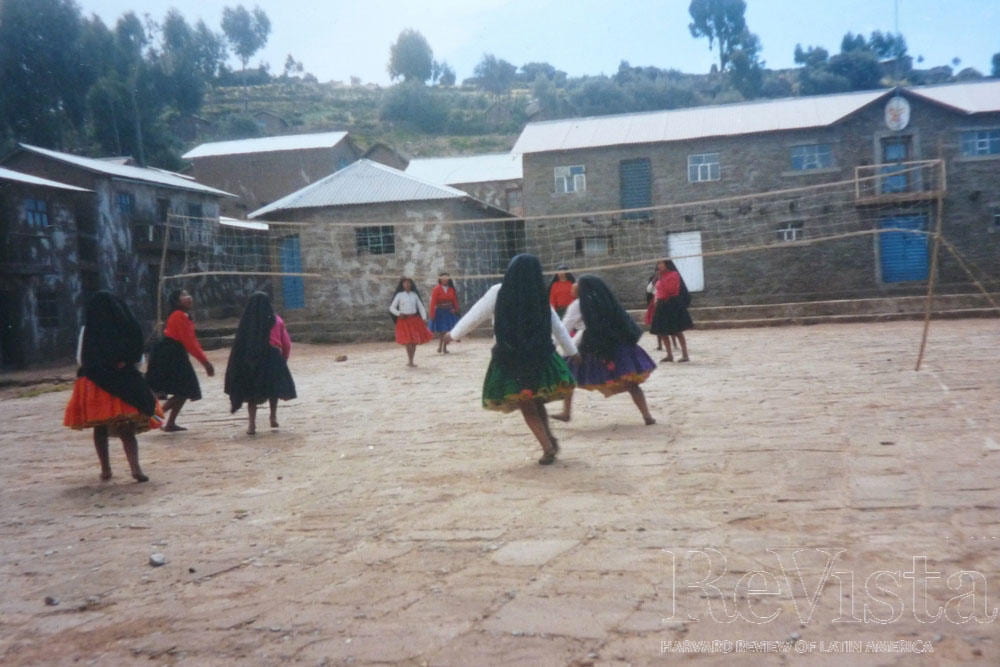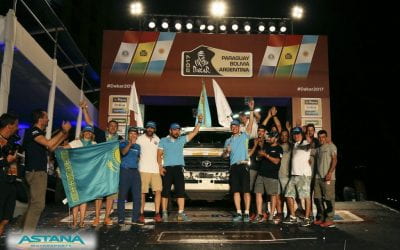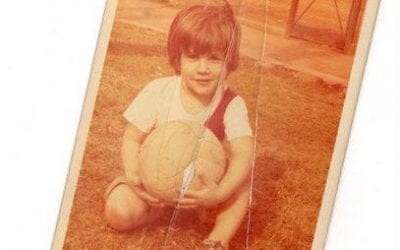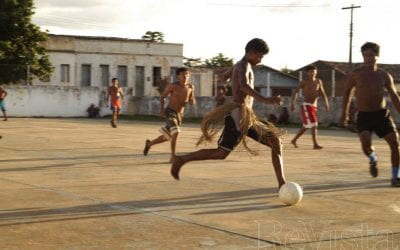One of the many vivid memories of my first stay in Peru involved listening to a radio commentary of the national women’s volleyball team as they played against the Soviet Union in the final of the 1988 Olympic Games. The commentary was playing on a series of buses I took on my way home from downtown Lima, and the passengers were living the drama of every point, bound up in the efforts of these women to bring glory to the nation. After five closely-fought sets, the Soviet team prevailed, but above and beyond the silver medal the Peruvian team won (the country’s only medal of the 1988 Games), the women who played had achieved the rare feat of becoming female representatives of the nation on an international stage. Volleyball has continued to be an arena in which Peruvian women gain a national profile, but since the turn of the new millennium other female athletes have come to prominence in the country, especially through surfing and, most recently, boxing. Sofía Mulánovich became a household name in Peru after being crowned women’s surfing world champion in 2004, and when I found myself confronted with images of her on roadside advertising hoardings, in shopping malls and local newspapers, shortly afterwards it struck me that something had changed in the representation and public presence of women in the country. The success of sportswomen seemed to be playing a key role in this process and I began to study the presence of women in Peruvian sports as part of a broader project to explore shifts in the country’s cultural identity.
Archival research in Lima has revealed that the practice of sports by Peruvian women can be traced back to the late nineteenth century, when gymnastics and callisthenic exercises were part of the curriculum in schools for girls such as thecolegio Rodó and the liceo Fanning. The founder of the latter, Teresa González de Fanning, published in 1898 a series of articles entitled Educación femenina, in which she advocated physical education for girls as an important means of engaging with the latest scientific trends and of preparing them for the rigors of life. In line with the Lamarckian thinking that was prevalent at the time—which claimed that acquired characteristics could be passed to one’s children—physical education was also seen as a way of improving the national character, and González de Fanning embraced this as another reason for the participation of girls in physical exercise. Her contribution to national efforts to address what was seen as the national ailment of molicie (softness) and forge hombres de acción (men of action) has to be understood in the context of Peru’s catastrophic loss to Chile in the War of the Pacific (1879-83), in which González de Fanning lost her husband during the battle of Miraflores (1881). In her excellent 2001 study Diversiones públicas en Lima 1890-1920 (Public Entertainments in Lima 1890-1920) Fanni Muñoz Cabrejo devotes some consideration to the presence of women in sport during this period, finding that it was largely restricted to women of the socio-economic elite, and to women from the expatriate communities, who typically enjoyed golf, tennis and horse racing.
The first decades of the twentieth century were crucial in the development of sports in Peru and saw the beginnings of mass participation, notably in soccer, in which the early presence of women’s teams was short-lived. Articles in the Peruvian press began to discuss the importance of physical exercise for women from the turn of the century, albeit with certain limitations: the transcript of a lecture given in San Marcos University, published over two numbers of El Sport in September-October 1899, advocates regular exercise for women, but recommends that tennis, cycling, rowing, moderate walking and gymnastic exercises are “most suited to women’s structure and character.” Needless to say, all of these sporting practices—with the exception of walking—require equipment and a locale that were beyond the reach of the great majority of women. In addition to these practical obstacles to widespread presence of women in sports, there were also a series of objections from traditionalists, who saw in the practice of sport risks to women’s reproductive function and the danger of their becoming masculinized. The strength of feeling was such that some parents withdrew their daughters from schools that introduced physical education to the curriculum around the turn of the century, and the cartoon reproduced here, from 1920, suggests that public attitudes to women in sports had not changed significantly over the following two decades.
By juxtaposing the “natural sport” of motherhood with a series of sporting practices that are portrayed as unnatural, explicitly in visual form and implicitly by textual contrast with the final caption, traditional notions of a woman’s physicality were forcefully expressed. The view among influential sectors of society that sports were not the way to achieve physical health for women is reinforced by a series of advertisements in the same issue of Variedades that offer a variety of medical treatments to improve women’s wellbeing. Indeed, the page facing the cartoon offers an exaggeratedly outmoded vision of elegant domesticity, recommending aspirin and caffeine tablets as the remedy to combat constitutional frailty: “The woman’s nervous system is so sensitive and her organism so delicate that daily domestic chores and social commitments cause her constant health problems.” Other advertisements in the same number offer means of improving women’s appearance or attractiveness to men, such as the antiperspirant Odo-ro-no, marketed under the headline that “You will not be charming until you are free from perspiring armpits.” Women were to be admired for their beauty, helped to overcome their weakness, and mocked when they sought to express their physicality through means other than motherhood.
The 1920s in particular saw the expansion of sport in Peru beyond the socio-economic elite: soccer became hugely popular among men of all classes, and by the early 1930s Alianza Lima, a team built around black players from the working-class neighbourhood of La Victoria, had established itself as the best in the country. For women, volleyball emerged as a widely practiced sport in the 1920s. In contrast to the mocking representation of sporting women in the edition of 1920 discussed above, Variedades in September 1928 carried a page of photographs that describe the sporting action in terms comparable to those used for football matches on preceding pages in the same edition.
The establishment of volleyball as the sport of Peru’s women is a curious phenomenon, dating back to soon after a 1910 YMCA delegation introduced the sport to the country. According to a series of special supplements published in El Comerciobetween July and September 1986 (entitled The Wonderful World of Volleyball), volleyball was soon played in private girls’ schools—a welcome addition to the gymnastic exercise routines that formed the basis of physical education. In a process that parallels what happened in soccer, volleyball was quickly appropriated by female domestic servants who would play the game in Lima’s parks and open spaces by the 1930s, leading to the sport being commonly known at that time as “the sport of cooks.” Following the creation of a league in 1933 and a national federation in 1942, Peruvian women’s volleyball claimed its first major international success in 1964, when the national team won the South American championships, going on to defend their title in 1967. Since then, Peru’s women have been at the forefront of international volleyball, and the introduction to the El Comercio supplements (which ran alongside a similar series produced for the 1986 Soccer World Cup) acknowledges that women’s volleyball “has written into the annals of national sport the greatest number of victories and honors” (July 1986, p.4). While this success has no doubt helped to break down traditional perceptions of women, especially those from less privileged backgrounds, the acceptance and celebration of volleyball as the sport for Peruvian women par excellence simultaneously betrays enduring conservatism: volleyball’s initial acceptance can be explained in good measure because it conformed to the perceptions of early twentieth-century society as to what constituted appropriate types of physical exercise for women. Muñoz Cabrejo sums this up as forms of exercise that “developed flexibility and agility” (p.208), both characteristic features of volleyball; moreover, the lack of men’s volleyball teams means that the women’s success was not seen in terms of a direct comparison—or threat—to an otherwise male-dominated sporting environment.
Volleyball is far from the only sport in which Peruvian women have excelled. Peru’s 1,500 miles of Pacific coastline make it an ideal surfing location, and the sport has proved increasingly popular since its introduction in the early 1940s, initially among the white elites of coastal cities, but more recently among other sectors of society, particularly the middle classes and women. Although Peru has had previous world champions from the ranks of its male surfers, Sofía Mulánovich’s overall triumph on the Association of Surfing Professionals (ASP) world tour series in 2004 brought her a public and media profile in Peru that were unprecedented for a sportswoman. Electronic media in particular (Mulánovich has her own website) have ensured that this profile has been international as well as national: from 2005-08 she was voted the most popular female surfer in the annual poll conducted by Surfer Magazine, and in 2007 she became the first South American to be inducted into the Surfers’ Hall of Fame, the same year seeing her finish as runner up in the world championships. Her consistent success and recognition beyond Peru (most recently, she won gold in the International Surfing Association World Surfing Games held in China in January 2012) feeds back directly into national pride at her achievements in a country that continues to occupy a complicated position in relation to the modern and the traditional, the local and the global. Mulánovich, known simply as la gringa, finds herself at the point of convergence of various strands in this ongoing process of cultural realignment: as a blonde woman from a surfing family of Croatian descent she embodies traditional notions of femininity while simultaneously challenging long-held assumptions regarding the position and visibility of women in society. Alongside Mulánovich in the Peruvian team that won the ISA World Surfing Games in October 2010 was Analí Gómez, and the two women featured prominently with their male teammates in a rare display of Peruvian team supremacy beyond women’s volleyball. Gómez, known simply as la negra, is a multiple South American champion, and was runner-up in the World Junior Championships in 2007. Her position as a mixed-race woman surfer from humble socio-economic origins provides a more significant challenge to the established norms of Peruvian identity than Mulánovich. It is difficult to gauge whether her lesser public profile in the country can be explained in purely sporting terms—her achievements are outstanding, but not quite at the level of Mulánovich’s—or by factors that owe more to social and cultural issues.
Mulánovich was beaten to the title of Peruvian women’s champion in 1996 by Kina Malpartida, her main rival as a teenager, who shares her surfing family history and upper middle class (partly) European descent: Malpartida’s father was a Peruvian surfing champion and her mother an English supermodel. While studying at college in Australia, Malpartida took up boxing, which she pursued by moving to Los Angeles in 2006. In 2009, she became world champion in the women’s WBA super-featherweight category. Surfing’s emphasis on aesthetics and on flow may share some of the “feminine” characteristics identified in sports appropriate for women in the early 20th century, such as flexibility and agility, helping to explain why this—alongside volleyball—has become a sport in which women’s success enjoys such public recognition, but Malpartida’s move into boxing placed her squarely outside the parameters of Peru’s normative femininity. Nonetheless, it has brought her a public profile that places her on a par with Mulánovich: she was voted Peru’s most popular athlete (male or female) in a 2009 poll conducted by Ipsos Apoyo, and the same year saw her receive a global leadership award from the Latin Business Association, in recognition of her position as a role model for women and children.
During campaigning for the presidential elections in April 2011, Malpartida joined Keiko Fujimori for a photoshoot in a gym, where she gave the presidential hopeful a pair of pink boxing gloves, a fitting symbol perhaps of the shifts in the balance of power and modes of public presence for Peruvian women to which sports have made a significant contribution. Malpartida was clearly acting in a supporting role here to the aspirations of another woman, but the role of sport in the acquisition of political agency has gone beyond gender politics and cultural politics to be assumed more directly by other sportswomen. Cecilia Tait, captain of the volleyball team that won the silver medal at the 1988 Olympic Games, is widely recognized as one of Peru’s outstanding athletes: she was named the world’s best player after the 1988 Olympic Games, received the Pierre de Coubertin medal and the Women in Sport trophy from the IOC in 2003. She was the first South American to be inducted (in 2005) into the Volleyball Hall of Fame. In the national elections of 2000, Tait’s profile as an outstanding sportswoman, alongside experience gained as a councillor in one of Lima’s poorer districts, served as the basis for her election to Peru’s Congress, becoming the first Afro-Peruvian to serve as an elected representative at this level. Her popularity as a congresistawas confirmed in the 2011 elections, when she headed the list of candidates for Alejandro Toledo’s Perú Posible party and was re-elected to Congress with the ninth highest vote count among the 468 candidates to stand in the capital. Also elected to Peru’s Congress in 2011 were Gaby Pérez del Solar and Cenaida Uribe, both part of the team at the 1988 Olympic Games (Pérez del Solar had previously served during the 2006-11 Congressional term), as well as Leyla Chihuán, captain of the national women’s volleyball team from 2006-10.
Women are no longer cooks who play volleyball in their spare time, but can be internationally successful athletes whose discipline, endeavour and commitment enable them to be recognized as valued members of the national community and to go on to gain public office. These attributes compare favorably with the headlines around Peruvian soccer, which—despite securing a commendable third place in the 2011 Copa América—is renowned in recent times for a series of power struggles, pre-match parties and player peccadilloes. Sports have provided a space within which women have been able to demonstrate their abilities and prove their international excellence, all of which has seen them increasingly recognized as a significant factor in the construction of a sense of modern nationhood. The achievements of female volleyball players, surfers and boxers have played an important part in breaking down barriers that are not just about gender, but also ethnicity, evident in the appointment in July 2011 of Susana Baca as Minister of Culture in the government of President Humala, thus making her the country’s first black government minister. Baca’s long career as a singer reminds us that sport is not the only sphere in which women have achieved public recognition, and that it is one—significant—aspect of broader social, cultural and political change in the country, change that it still being played out in the sporting arena and beyond.





